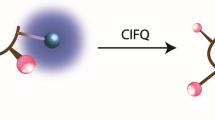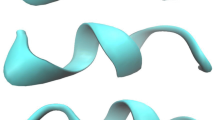Abstract
Our aim was to study the impact of two proline chimeras, containing a glutamic acid side chain in cis- or trans-configuration, on secondary structure formation. We further investigated to what extent the configuration of the side chain contributes to the overall peptide conformation. We used a 10 residue peptide (IYSNPDGTWT) that forms a β-hairpin in water. The turn-forming proline was substituted with either a cis- or trans-proline-glutamic acid chimera, resulting in the peptides IYSNP cis-EDGTWT (P1_P cis-E) and IYSNP trans-EDGTWT (P1_P trans-E). We studied the conformation of the modified peptides by circular dichroism (CD) and NMR-spectroscopy, and SEC/static light scattering (SLS) analysis. NMR analysis reveals that the modified peptides maintain the β-hairpin conformation in aqueous solution. At 5 °C and pH 4.3, the peptide (P1_P cis-E) was found to adopt two coexisting β-hairpin conformations (2:2 β-hairpin, and 3:5 β-hairpin). In contrast to that, the peptide (P1_P trans-E) adopts a 2:2 β-hairpin that exists in equilibrium with a 4:4 β-hairpin conformation. The adoption of ordered β-hairpin structures for both modified peptides could be confirmed by CD spectroscopy, while SEC/SLS analysis showed a monomeric oligomerization state for all three investigated peptides. With the combination of several NMR methods, we were able to elucidate that even small alterations in the side chain conformation of the proline-glutamate chimera (cis or trans) can significantly influence the conformation of the adopted β-hairpin.







Similar content being viewed by others
Abbreviations
- CD:
-
Circular dichroism
- HPLC:
-
High performance liquid chromatography
- Fmoc:
-
Fluorenylmethoxy carbonyl
- AU:
-
Analytical ultracentrifugation
- SEC:
-
Size exclusion chromatography
- MD:
-
Molecular dynamics
- DIC:
-
Diisopropylcarbodiimide
- HOBT:
-
1-Hydroxybenzotriazole
- HOAT:
-
1-Hydroxy-7-azabenzotriazole
- TFA:
-
Trifluoroacetic acid
- TIS:
-
Triisopropylsilane
- Pcis-E :
-
cis-Proline glutamate chimera
- Ptrans-E :
-
trans-proline glutamate chimera
- NMR:
-
Nuclear magnetic resonance
- 1H NMR:
-
Proton nuclear magnetic resonance
- COSY:
-
Correlation spectroscopy
- TOCSY:
-
Total correlation spectroscopy
- NOE:
-
Nuclear Overhauser effect
- NOESY:
-
Nuclear Overhauser effect spectroscopy
- ROESY:
-
Rotating frame nuclear Overhauser effect spectroscopy
- SPPS:
-
Solid phase peptide synthesis
References
Aubry A, Vitoux B, Marraud M (1985) Conformational properties of Pro–Pro sequences. I. Crystal structures of two dipeptides with l-Pro-l-Pro and l-Pro-d-Pro sequences. Biopolymers 24:1089–1100
Aue WP, Bartholdi E, Ernst RR (1976) Two-dimensional spectroscopy. Application to nuclear magnetic resonance. J Chem Phys 64:2229–2246
Blanco FJ, Jimenez MA, Herranz J, Rico M, Santoro J, Nieto JL (1993) NMR evidence of a short linear peptide that folds into a β-hairpin in aqueous solution. J Am Chem Soc 115:5887–5888
Blanco FJ, Rivas G, Serrano L (1994) A short linear peptide that folds into a native stable β-hairpin in aqueous solution. Nat Struct Biol 1:584–590
Bothner-By AA, Stephens RL, Lee J, Warren CD, Jeanloz RW (1984) Structure determination of a tetrasaccharide: transient nuclear Overhauser effects in the rotating frame. J Am Chem Soc 106:811–813
Braunschweiler L, Ernst RR (1983) Coherence transfer by isotropic mixing: application to proton correlation spectroscopy. J Magn Reson 53:521–528
Chatterjee B, Saha I, Raghothama S, Aravinda S, Rai R, Shamala N, Balaram P (2008) Designed peptides with homochiral and heterochiral diproline templates as conformational constraints. Chem Eur J 14:6192–6204
Coin I, Beyermann M, Bienert M (2007) Solid-phase peptide synthesis: from standard procedures to the synthesis of difficult sequences. Nat Protoc 2:3247–3256
de Alba Ed, Jiménez MA, Rico M, Nieto JL (1996) Conformational investigation of designed short linear peptides able to fold into β-hairpin structures in aqueous solution. Fold Des 1:133–144
de Alba E, Jiménez MA, Rico M (1997) Turn residue sequence determines β-Hairpin conformation in designed peptides. J Am Chem Soc 119:175–183
Delaye PO, Vasse JL, Szymoniak J (2010) Asymmetric synthesis of proline-based conformationally constrained tryptophan mimetic. Org Biomol Chem 8:3635–3637
Dyson HJ, Wright PE (1991) Defining solution conformations of small linear peptides. Annu Rev Biophys Biophys Chem 20:519–538
Dyson HJ, Wright PE (1993) Peptide conformation and protein folding. Curr Opin Struct Biol 3:60–65
Fatas P, Jimenez AI, Calaza MI, Cativiela C (2012) β-Phenylproline: the high β-turn forming propensity of proline combined with an aromatic side chain. Org Biomol Chem 10:640–651
Fernández-Escamilla AM, Ventura S, Serrano L, Jiménez MA (2006) Design and NMR conformational study of a β-sheet peptide based on Betanova and WW domains. Protein Sci 15:2278–2289
Gerling UIM, Brandenburg E, Berlepsch Hv, Pagel K, Koksch B (2010) Structure analysis of an amyloid-forming model peptide by a systematic glycine and proline scan. Biomacromolecules 12:2988–2996
Guitot K, Larregola M, Pradhan TK, Vasse JL, Lavielle S, Bertus P, Szymoniak J, Lequin O, Karoyan P (2011) The combination of prolinoamino acids and cyclopropylamino acids leads to fully functionalized, stable β-turns in water. Chembiochem 12:1039–1042
Haque TS, Little JC, Gellman SH (1994) “Mirror image” reverse turns promote β-hairpin formation. J Am Chem Soc 116:4105–4106
Haque TS, Little JC, Gellman SH (1996) Stereochemical requirements for β-hairpin formation: model studies with four-residue peptides and depsipeptides. J Am Chem Soc 118:6975–6985
Horne WS, Price JL, Keck JL, Gellman SH (2007) Helix bundle quaternary structure from α/β-peptide foldamers. J Am Chem Soc 129:4178–4180
Horne WS, Johnson LM, Ketas TJ, Klasse PJ, Lu M, Moore JP, Gellman SH (2009) Structural and biological mimicry of protein surface recognition by α/β-peptide foldamers. Proc Nat Acad Sci USA 106:14751–14756. doi:10.1073/pnas.0902663106
Ishikawa Y, Oka M, Hayashi T, Nishinaga A (1996) Theoretical analysis of α-helix hairpin structures constructed by two right-handed α-helices. Polym J 28:86–90
Ivanova G, Yakimova B, Angelova S, Stoineva I, Enchev V (2010) Influence of pH on the cis-trans isomerization of valine-proline dipeptide: an integrated NMR and theoretical investigation. J Mol Struct 975:330–334
Jeener J, Meier BH, Bachmann P, Ernst RR (1979) Investigation of exchange processes by two-dimensional NMR spectroscopy. J Chem Phys 71:4546–4553
Kang YK, Young Choi H (2004) Cis-trans isomerization and puckering of proline residue. Biophys Chem 111:135–142
Karoyan P, Quancard J, Vaissermann J, Chassaing Gr (2003) Amino-zinc-enolate carbometalation reactions: application to ring closure of terminally substituted olefin for the asymmetric synthesis of cis- and trans-3-prolinoleucine. J Org Chem 68:2256–2265
Kim PS, Baldwin RL (1990) Intermediates in the Folding Reactions of Small Proteins. Annu Rev Biochem 59:631–660
Kumar A, Ernst RR, Wüthrich K (1980) A two-dimensional nuclear Overhauser enhancement (2D NOE) experiment for the elucidation of complete proton–proton cross-relaxation networks in biological macromolecules. Biochem Biophys Res Commun 95:1–6
Lakshminarayanan R, Yoon I, Hegde BG, Fan D, Du C, Moradian-Oldak J (2009) Analysis of secondary structure and self-assembly of amelogenin by variable temperature circular dichroism and isothermal titration calorimetry. Proteins: Struct Funct Bioinf 76:560–569
Lengyel GA, Frank RC, Horne WS (2011) Hairpin folding behavior of mixed α/β-peptides in aqueous solution. J Am Chem Soc 133:4246–4249
Loughlin WA, Tyndall JDA, Glenn MP, Hill TA, Fairlie DP (2010) Update 1 of: β-strand mimetics. Chem Rev 110:32–69
MacArthur MW, Thornton JM (1991) Influence of proline residues on protein conformation. J Mol Biol 218:397–412
Maity J, Saha P, Gerling UIM, Lentz D, Koksch B (2012) An approach for simultaneous synthesis of cis- and trans-3-substituted proline-glutamic acid chimeras. Synthesis 44:3063–3070
Mezzache S, Afonso C, Pepe C, Karoyan P, Fournier F, Tabet JC (2003) Proton affinity of proline and modified prolines using the kinetic method: role of the conformation investigated by ab initio calculations. Rapid Commun Mass Spectrom 17:1626–1632
Milner-White EJ, Bell LH, Maccallum PH (1992) Pyrrolidine ring puckering in cis and trans-proline residues in proteins and polypeptides. Different puckers are favoured in certain situations. J Mol Biol 228:725–734
Mothes C, Larregola M, Quancard J, Goasdoué N, Lavielle S, Chassaing G, Lequin O, Karoyan P (2010) Prolinoamino acids as tools to build bifunctionalized, stable β-turns in water. Chembiochem 11:55–58
Munoz V, Thompson PA, Hofrichter J, Eaton WA (1997) Folding dynamics and mechanism of β-hairpin formation. Nature 390:196–199
Nesloney CL, Kelly JW (1996) A 2,3′-substituted biphenyl-based amino acid facilitates the formation of a monomeric β-hairpin-like structure in aqueous solution at elevated temperature. J Am Chem Soc 118:5836–5845
Oba M, Saegusa T, Nishiyama N, Nishiyama K (2009) Synthesis of non-proteinogenic amino acids using Michael addition to unsaturated orthopyroglutamate derivative. Tetrahedron 65:128–133
Pagel K, Wagner SC, Samedov K, von Berlepsch H, Böttcher C, Koksch B (2006) Random coils, β-sheet ribbons, and α-helical fibers: one peptide adopting three different secondary structures at will. J Am Chem Soc 128:2196–2197
Price JL, Horne WS, Gellman SH (2010) Structural consequences of β-amino acid preorganization in a self-assembling α/β-peptide: fundamental studies of foldameric helix bundles. J Am Chem Soc 132:12378–12387
Ramirez-Alvarado M, Blanco FJ, Serrano L (1996) De novo design and structural analysis of a model β-hairpin peptide system. Nat Struct Biol 3:604–612
Rance M (1987) Improved techniques for homonuclear rotating-frame and isotropic mixing experiments. J Magn Reson 74:557–564
Rezaei Araghi R, Baldauf C, Gerling UIM, Cadicamo CD, Koksch B (2011) A systematic study of fundamentals in α-helical coiled coil mimicry by alternating sequences of β- and γ-amino acids. Amino Acids 41:733–742
Robinson JA (2008) β-Hairpin peptidomimetics: design, structures and biological activities. Acc Chem Res 41:1278–1288
Searle MS, Williams DH, Packman LC (1995) A short linear peptide derived from the N-terminal sequence of ubiquitin folds into a water-stable non-native β-hairpin. Nat Struct Biol 2:999–1006
Sibanda BL, Blundell TL, Thornton JM (1989) Conformation of β-hairpins in protein structures. A systematic classification with applications to modelling by homology, electron density fitting and protein engineering. J Mol Biol 206:759–777
Sugawara M, Tonan K, Ikawa S-i (2001) Effect of solvent on the cis-trans conformational equilibrium of a proline imide bond of short model peptides in solution. Spectrochim Acta A Mol Biomol Spectrosc 57:1305–1316
Thunecke F, Kálmán A, Kálmán F, Ma S, Rathore AS, Horváth C (1996) Kinetic study on the cis-trans isomerization of peptidyl-proline dipeptides. J Chromatogr 744:259–272
Williams AD, Portelius E, Kheterpal I, Guo JT, Cook KD, Xu Y, Wetzel R (2004) Mapping αβ amyloid fibril secondary structure using scanning proline mutagenesis. J Mol Biol 335:833–842
Wilmot CM, Thornton JM (1988) Analysis and prediction of the different types of β-turn in proteins. J Mol Biol 203:221–232
Wishart DS, Sykes BD, Richards FM (1991) Relationship between nuclear magnetic resonance chemical shift and protein secondary structure. J Mol Biol 222:311–333
Wu YD, Han W, Wang DP, Gao Y, Zhao Y-L (2008) Theoretical Analysis of Secondary Structures of β-Peptides. Acc Chem Res 41:1418–1427
Wüthrich K (1986) NMR of proteins and nucleic acids. Wiley, New York
Wüthrich K, Billeter M, Braun W (1984) Polypeptide secondary structure determination by nuclear magnetic resonance observation of short proton–proton distances. J Mol Biol 180:715–740
Zimmerman SS, Scheraga HA (1976) Stability of cis, trans, and nonplanar peptide groups. Macromolecules 9:408–416
Acknowledgments
The authors thank the Center for International Cooperation and the Dahlem Research School of Freie Universität Berlin for funding.
Conflict of interest
The authors declare that they have no conflict of interest.
Author information
Authors and Affiliations
Corresponding author
Additional information
J. Maity and U. I. M. Gerling contributed equally.
Electronic supplementary material
Below is the link to the electronic supplementary material.
Rights and permissions
About this article
Cite this article
Maity, J., Gerling, U.I.M., Vukelić, S. et al. Proline-glutamate chimera’s side chain conformation directs the type of β-hairpin structure. Amino Acids 46, 177–186 (2014). https://doi.org/10.1007/s00726-013-1610-1
Received:
Accepted:
Published:
Issue Date:
DOI: https://doi.org/10.1007/s00726-013-1610-1




